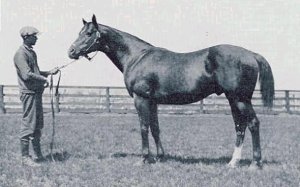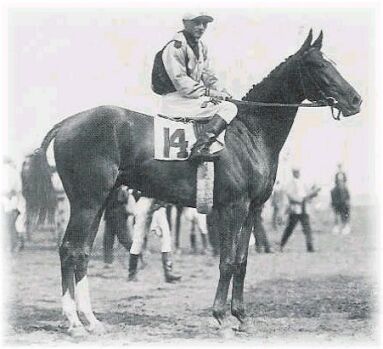

Among the fastest horses of the 1920's was the brilliant sprinter Sarazen, who successfully stretched his speed to win the mile and a quarter long International Special in track record time. The gelding's repeated triumphs prompted the great breeder John E. Madden to complain:
"When a man can breed a Quarter Horse to a plow mare and get a horse that can beat everything in America, it's time for me to sell out."
The quote referred to the fact that Sarazen's sire
High Time, a stocky son of Ultimus, was so severely inbred to
Domino, a major source of American speed, that he had
severely lacked stamina.  In addition, Sarazen's unraced
dam, Rush Box, had apparently been used, occasionally, to
pull a plow for owner George Carley. Despite her menial
chores, the broodmare carried the blood of both 1880 Epsom
Derby winner Bend Or and the great English racehorse St.
Simon, the unbeaten winner of the Ascot Gold Cup.
In addition, Sarazen's unraced
dam, Rush Box, had apparently been used, occasionally, to
pull a plow for owner George Carley. Despite her menial
chores, the broodmare carried the blood of both 1880 Epsom
Derby winner Bend Or and the great English racehorse St.
Simon, the unbeaten winner of the Ascot Gold Cup.
Bred by Dr. Marius E. Johnston, Sarazen, named for a famous golfer, was one of two High Time yearlings sold to Colonel Phil T. Chinn, the stallion's former trainer, for a total of $2,400. Wearing Colonel Chinn's silks, Sarazen won his first three starts by a combined total of fourteen and a half lengths, and was then sold to Mrs. Grahan Fair Vanderbilt III for $35,000. Time Exposure was also sold, going to Frank Farrell for $15,000. Even with the profit of $47,600, Colonel Chinn later felt cheated, saying he had made "a sucker play. I sold the horse for $35,000, and he was worth $100,000."
Under the management of Max Hirsch, the trainer at Fair Stable, the chestnut gelding continued to win. First he galloped away from an allowance field to win by four and a half lengths. Then he proved himself one of the nation's leading juveniles with a two length win in the Champagne Stakes. Both times rider Earl Sande had him under restraint.
Sarazen led wire to wire in the Oakdale Handicap, winning by two lengths despite carrying 127 pounds and giving nineteen pounds to runner up Sun Pal. He stretched out to a mile and romped home in an allowance event at Laurel.
In the National Stallion Stakes he beat Moon Star by two lengths while conceding him ten pounds. He added the Laurel Special to his list of victories, then met older horses in the Fall Serial #2 at Pimlico. The event was weight-for-age, and Sarazen took advantage of the situation, sprinting away from the consistent stakes winners General Thatcher and Blazes to win as he pleased.

Sarazen was ranked among the leading juveniles after his undefeated ten race campaign, but having failed to meet either Futurity winner St. James or the talented Wise Counsellor he didn't earn a championship. His winnings totaled $37,880.
Sarazen was made the early favorite for the 1924 Kentucky Derby, but left the fiftieth anniversary running of the famous race to the appropriately named Black Gold. He made his debut instead at Jamaica, where he finished second in a six furlong sprint. After two months of rest, during which the filly Nellie Morse took the Preakness and Mad Play won the Belmont Stakes, Sarazen came back to go wire to wire in the Carter Handicap, winning eased up.
The little chestnut also returned to the winner's circle after the Fleetwing Handicap, cantering off to win by three lengths.
He finally met, and defeated, Wise Counsellor in the Saranac Handicap, despite a poor start. Sarazen also scored an easy victory in a muddy Huron Handicap while giving away weight.
He next met Belmont Stakes winner Mad Play and Greentree Stable's Cherry Pie in the Manhattan Handicap, and despite giving weight to both he was eased at the wire, winning by a length.
Assigned 135 pounds for the Fall Highweight Handicap, Sarazen couldn't overcome a bad start and finished third behind Worthmore and Shuffle Along. He recovered to beat 1923 Horse of the Year Zev in the Arverne Handicap at Aqueduct, then went to post in the International Special No. 3.
In the third International Special, Sarazen met the French champion Epinard, as well as Belmont Stakes winner Mad Play and the top filly Princess Doreen, winner of the Kentucky Oaks, winner of the Coaching Club American Oaks, and conqueror of the colts on three occasions. Chilhowee, who had run second in Black Gold's Derby, set the early pace. Sarazen caught him after six furlongs and won easily in the track record time of 2:00 4/5 for a mile and a quarter. The chestnut gelding may have made victory look easy, but the fight for place money clearly wasn't so. Only a nose separated the next three finishers.
Sarazen showed courage when he held off the lightly weighted Rustic to win the Maryland Handicap by a head, despite tiring in the stretch. He couldn't repeat the performance the following week, however, and was out of the money in the Washington Handicap.
Sarazen was named Horse of the Year, as well as three-year-old champion. He was also the nation's leading money winner, earning $95,640 that season. Epinard earned the handicap division championship, while Princess Doreen shared her divisional honors with Preakness winner Nellie Morse.
The following season, the brilliant gelding won half of his starts, including the Dixie Handicap, the Fleetwing Handicap, the Arverne Handicap, and the Bryan Memorial. Once again, he was Horse of the Year.
During his five-year-old season, Sarazen grew sour, and although he was at the top of his division in 1926, he failed to win a single race at six or seven. His most notable performance during that time was a second place finish to Croyden in the Laurel Stakes. Max Hirsch tried numerous tactics with the moody horse, but was unsuccessful. Sarazen's racing career was over.
Retiring after the 1928 season, the chestnut gelding spent the rest of his days at Tom Piatt's Brookdale Farm. He passed away on December 12, 1940. Sarazen entered the Hall of Fame in 1957. Blood-Horse honored him with a ranking on their top one hundred list at the close of the twentieth century.
| Year | Starts | Wins | Seconds | Thirds | Earnings |
|---|---|---|---|---|---|
| Lifetime | 55 | 27 | 2 | 6 | $225,000 |
| High Time | Ultimus | Commando | Domino |
| Emma C. | |||
| Running Stream | Domino | ||
| Dancing Water | |||
| Noonday | Domino | Himyar | |
| Mannie Gray | |||
| Sundown | Springfield | ||
| Sunshine | |||
| Rush Box | Box | Order | Bend Or |
| Angelica | |||
| Pandora | Rayon d'Or | ||
| Blue Grass Belle | |||
| Sallie Ward | Singleton | St. Simon | |
| Field Azure | |||
| Belle Nutter | Faraday | ||
| Sarah F. |



This text protected by all applicable copyright laws. Do not duplicate or distribute without written permission. © Spiletta42.